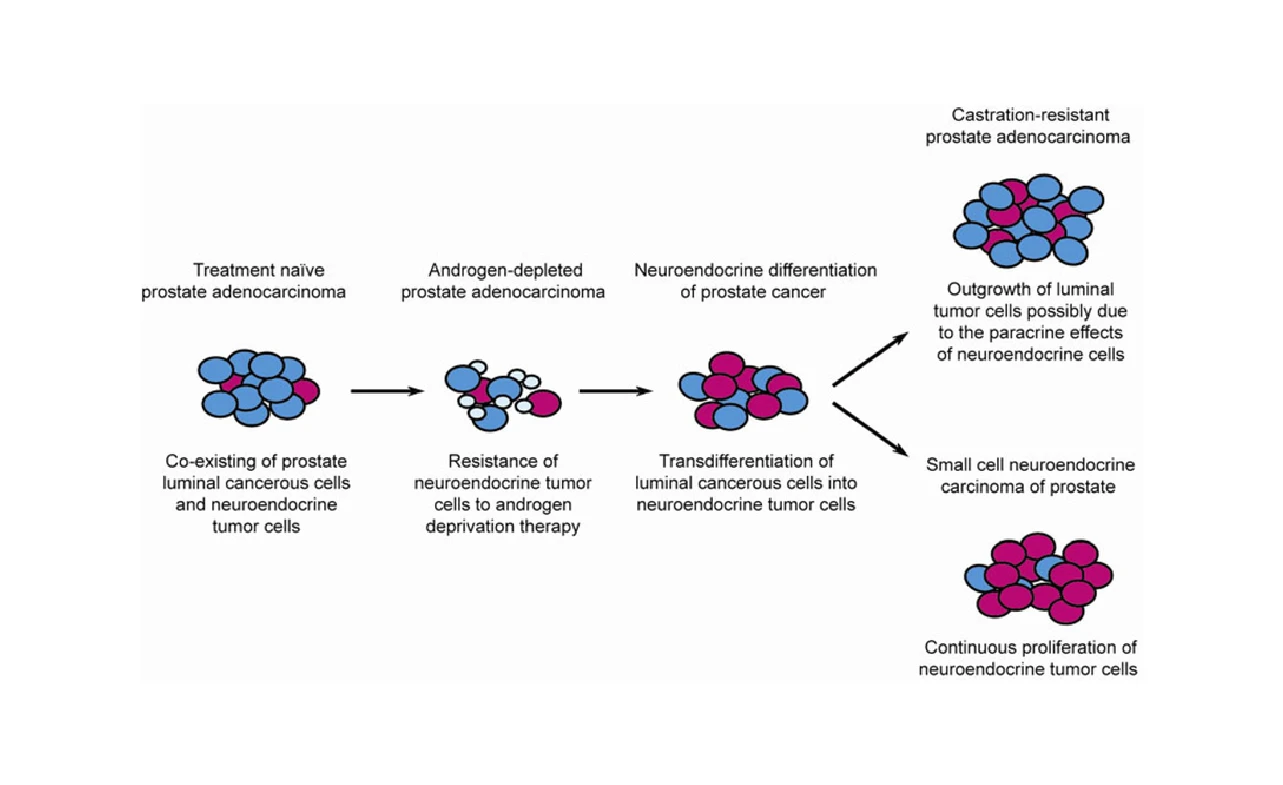Neuroendocrine prostate cancer (NEPC) is a rare and aggressive form of prostate cancer that differs significantly from the more common adenocarcinoma of the prostate. While most prostate cancers are slow-growing and hormone-dependent, neuroendocrine prostate cancer is known for its rapid progression and resistance to traditional hormone therapies. But what exactly is neuroendocrine prostate cancer, and how can patients and their loved ones navigate this challenging diagnosis?
In this article, we’ll explore the world of neuroendocrine prostate cancer, breaking down its causes, symptoms, diagnostic methods, and treatment options. Whether you’re a patient, caregiver, or simply someone seeking to understand this condition, this guide will provide you with valuable insights. By the end, you’ll have a clearer picture of what neuroendocrine prostate cancer entails and the hope that modern medicine offers.
What Is Neuroendocrine Prostate Cancer?
Neuroendocrine prostate cancer is a rare subtype of prostate cancer that arises from neuroendocrine cells in the prostate gland. These cells are responsible for producing hormones and neurotransmitters that regulate various bodily functions. Unlike the more common adenocarcinoma, which is driven by male hormones (androgens), neuroendocrine prostate cancer is hormone-independent, making it more challenging to treat.
NEPC can develop de novo (from the start) or as a result of treatment-resistant prostate cancer that transforms into a neuroendocrine phenotype. This transformation often occurs after prolonged hormone therapy, highlighting the aggressive nature of this cancer.
Symptoms of Neuroendocrine Prostate Cancer
The symptoms of neuroendocrine prostate cancer can vary depending on the stage of the disease and whether it has spread to other parts of the body. Here are some common symptoms to watch for:
- Urinary Issues: Difficulty urinating, frequent urination, or blood in the urine.
- Pelvic Pain: Discomfort or pain in the pelvic area, lower back, or hips.
- Fatigue: Persistent tiredness that doesn’t improve with rest.
- Weight Loss: Unexplained and unintentional weight loss.
- Neurological Symptoms: In advanced stages, the cancer may spread to the brain or spinal cord, causing headaches, dizziness, or weakness.
If you or a loved one is experiencing these symptoms, it’s important to consult a healthcare professional for further evaluation.
Causes and Risk Factors
The exact cause of neuroendocrine prostate cancer is still not fully understood. However, researchers have identified several risk factors that may increase the likelihood of developing this condition:
- Advanced Prostate Cancer: Patients with advanced or treatment-resistant prostate cancer are at higher risk of developing NEPC.
- Prolonged Hormone Therapy: Long-term use of androgen deprivation therapy (ADT) may contribute to the transformation of prostate cancer into a neuroendocrine phenotype.
- Genetic Mutations: Certain genetic changes, such as mutations in the RB1 or TP53 genes, have been linked to NEPC.
While these factors can contribute to the development of neuroendocrine prostate cancer, it’s important to note that many patients have no identifiable risk factors.
Diagnosing Neuroendocrine Prostate Cancer
Diagnosing neuroendocrine prostate cancer involves a combination of imaging tests, blood work, and biopsies. Here’s a breakdown of the diagnostic process:
1. Imaging Tests
- CT Scan: Provides detailed images of the prostate and surrounding organs.
- MRI: Offers a closer look at the structure of the prostate and any abnormalities.
- PET Scan: Helps identify active cancer cells in the body.
2. Blood Tests
- Prostate-Specific Antigen (PSA) Test: While PSA levels are often low in NEPC, this test is still used as part of the diagnostic process.
- Chromogranin A (CgA) Test: Measures levels of a protein often elevated in neuroendocrine tumors.
3. Biopsy
A small sample of prostate tissue is taken and examined under a microscope to confirm the presence of neuroendocrine cells.
Treatment Options for Neuroendocrine Prostate Cancer
The treatment plan for neuroendocrine prostate cancer depends on the stage of the disease and the patient’s overall health. Here are some common treatment options:
1. Chemotherapy
- Platinum-Based Chemotherapy: Drugs like cisplatin or carboplatin are often used to treat NEPC due to their effectiveness against aggressive cancers.
2. Radiation Therapy
- External Beam Radiation: Targets cancer cells in the prostate and surrounding areas.
- Radionuclide Therapy: Uses radioactive substances to target and destroy cancer cells.
3. Targeted Therapy
- PARP Inhibitors: Drugs that target specific genetic mutations in cancer cells.
4. Immunotherapy
- Checkpoint Inhibitors: Drugs that help the immune system recognize and attack cancer cells.
Living with Neuroendocrine Prostate Cancer
A diagnosis of neuroendocrine prostate cancer can be overwhelming, but there are ways to manage the condition and maintain a good quality of life. Here are some tips:
- Follow Your Treatment Plan: Adhering to your doctor’s recommendations is crucial for managing symptoms and slowing disease progression.
- Adopt a Healthy Lifestyle: Eating a balanced diet, exercising regularly, and avoiding smoking can support overall well-being.
- Seek Support: Joining a support group or connecting with others who have similar experiences can provide emotional comfort.
Frequently Asked Questions
Q: Is neuroendocrine prostate cancer curable?
A: While a complete cure may not always be possible, many patients live for years with effective treatment and management.
Q: What is the survival rate for neuroendocrine prostate cancer?
A: Survival rates vary depending on the stage of the cancer and the patient’s overall health. Early detection and treatment can significantly improve outcomes.
Q: Can diet affect neuroendocrine prostate cancer?
A: While diet alone cannot cure the condition, a healthy diet can support overall health and well-being.
Conclusion
Neuroendocrine prostate cancer is a complex and aggressive condition that requires a multidisciplinary approach to diagnosis and treatment. From understanding the symptoms to exploring the latest treatment options, patients and their families have more resources and hope than ever before. While the journey may be challenging, advancements in medical science continue to improve outcomes and quality of life for those affected.
- Understanding Neuroendocrine Carcinoid Cancer: Symptoms, Treatment, and Hope for Patients
- Understanding Neuroendocrine Cancer Liver: Symptoms, Treatment, and Hope for Patients
- Understanding Death from Neuroendocrine Cancer: Causes, Prevention, and Coping Strategies
- Understanding Small Cell Neuroendocrine Cancer: Symptoms, Diagnosis, and Treatment Options
